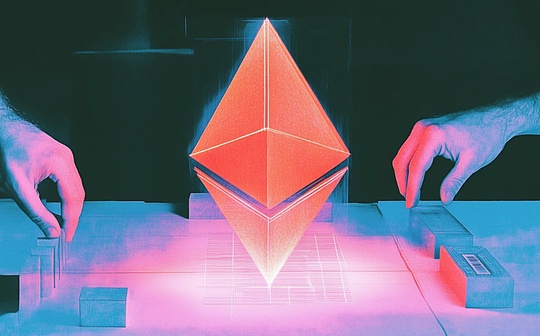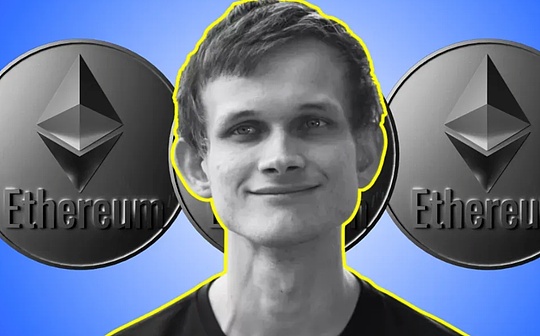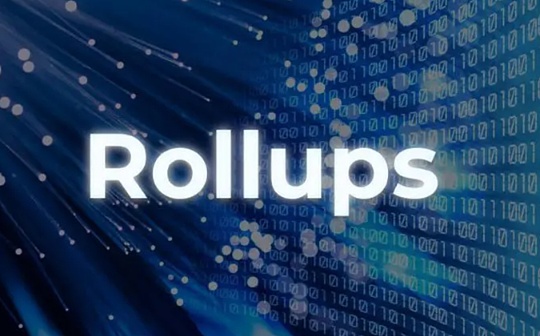
background
At present, the Ethereum Rollup L2 ecosystem has begun to take shape. The overall TVL in a single day exceeds $37b, more than 3 times that of Solana, and more than Ethereum’s VII.From the user’s perspective, the average number of daily users in mainstream L2 has reached 158k in recent days, exceeding the data of Solana about 100k.
However, Rollups’ currency price performance is lower than expected in the short term.In terms of market value, among the mainstream Rollups, Arbitrum has a market value of $7.8b, Optimism has a market value of $7.3b, Starknet has a market value of $6.9b, and the zkSync FDV that has just completed airdrops is $3.5b, while Solana’s FDV has reached $74b during the same period.zkSync has been launched recently, and its poor market performance has not met the market’s expectations for Rollups.
From the perspective of revenue, Ethereum’s revenue reached $2b in 2023, while the annual revenue of Arbitrum and Op Mainnet, which performed well in the same year, reached $63m and $37m respectively, which is a big gap with Ethereum.Base and zkSync, which performed well in the new market this year, received $50m and $23m revenue in the first half of 2024, respectively, while Ethereum generated $1.39b revenue during the same period, and the gap has not yet narrowed.Rollups has not yet achieved a revenue scale that matches Ethereum.
Some Rollups’ current low activity is certainly a reason, which is a problem faced by most public chains.What we want to know more is how accomplished Rollups is in its mission as a Mass adoption infra, and is its value underestimated due to its current low activity?
Everything still needs to go back to the earliest propositions. The birth of Rollups originated from the increasing crowding of Ethereum, and the fees reached a level that users could not accept.Therefore, Rollups is born with the purpose of “reducing transaction costs”.The advantages of Rollups, in addition to the well-known Ethereum L1 level security, also include its disruptive cost structure, the so-called “the more users, the cheaper Rollups are.”
If this can be implemented well, we believe that Rollups have irreplaceable value.A more reasonable cost structure can also improve Rollups’ resilience in the face of market changes.Continuous investment brought by healthy cash flow is the source of competitiveness, and agreements with advantages in profit margins will naturally have higher valuations and long-term competitiveness.
This article briefly analyzes the current economic structure of Rollups and looks forward to the possibilities in the future.

1.Rollups’ business model
1.1 Overview
The Rollups protocol uses Sequencer as a revenue and fulfilment point to charge users’ transactions on Rollups to cover costs incurred on L1 and L2, as well as to obtain additional profits.
On the revenue side, the fees charged by Rollups to users include:
-
Basic expenses (including congestion expenses)
-
Priority Fees
-
L1 related costs
Potential expenses that can be captured by the protocol’s own strategy include:
-
MEV Fees
The cost side includes the L2 execution costs that currently account for a small proportion and the L1 costs that account for the main part, including:
-
DA Cost
-
Verification Cost
-
Communication costs
Rollups’ business model is different from other L2’s business models in terms of its cost structure. For example, the largest proportion of DA costs are considered variable costs with the amount of data, and verification costs and communication costs are more considered fixed to maintain Rollups’ operation.cost.
From the perspective of business model, we hope to clarify the marginal cost of Rollups, that is, the extent to which the new cost of an additional transaction can be less than the average cost of each transaction, to verify the specific degree of “the more users, the cheaper Rollup” is established.
The reason behind this is that Rollups batch processing of data, data compression, and verification aggregation, resulting in higher efficiency and lower marginal costs compared to other public chains.In theory, the fixed cost of Rollups can be well amortized into each transaction, so it can even be ignored if the transaction volume is large enough, but this also requires our verification.
1.2 Rollups Revenue
1.2.1 Transaction fee income
Rollups’ main income comes from transaction fees, namely gas. The purpose of the handling fee is to cover the cost of Rollups, and obtain part of the profit to hedge the risks of long-term L1 ga s changes, as well as obtain part of the profit.Some L2 will charge transaction priority fees, allowing users to prioritize emergency transactions.
Aribtrum and zkSync adopt the FCFS mechanism, that is, the order of transaction processing is first-come-first-processing, and does not support “cut-queue” requests.OP stack takes a flexible approach to such issues, allowing for “cut-line” payments for transactions.

Source: IOSG Ventures
For users, when the fees of Rollups L2 are less active on the chain, they will be determined by the lower limit basic fee.When the chain is relatively busy, each Rollups will charge a congestion fee (often exponentially increases).
Because Rollups’ L2 overhead is extremely low (only off-chain engineering and operation and maintenance costs only), and the execution costs charged are highly autonomous, the revenue used by almost all users to pay L2 fees will become the profit of the agreement.Due to the centralized operation of Sequencer, Rollups has control over the underlying fee lower limit, congestion fee, and priority fee. Therefore, L2 execution fee will be the “parameter” game of the agreement, which is more prosperous in the ecosystem and the price will not arouse users’ disgust.Under the , the execution cost can be designed .

Source: David_c @Dune Analytic
1.2.2 MEV revenue
MEV transactions are divided into malicious MEV and non-malicious MEV. The malicious MEV is a front-running transaction similar to a sandwich attack, which is more about robbing the user’s transaction value. For example, in a sandwich attack, the attacker will insert it before the user’s transaction.Their own transactions lead to users buying at higher prices or selling at lower prices, which is the so-called “clipped”.
Instead of malicious MEVs, such as arbitrage and liquidation, arbitrage can balance prices between different exchanges and improve market effectiveness; liquidation can remove bad leverage and reduce system risks, which is regarded as beneficialMEV behavior.
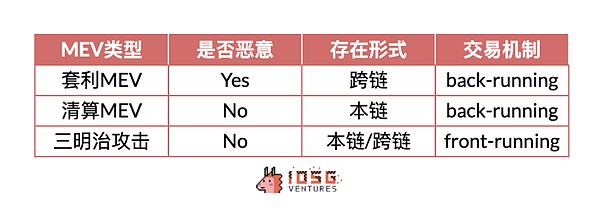
Source: IOSG Ventures
Unlike Ethereum, Rollups does not provide an open mempool. Only the sorter can see the transaction before the transaction is finalized. Therefore, only the sorter has the ability to initiate the MEV on the L2 chain, because most of the L2 are now central.The sequencer will not have malicious MEVs for the time being, so the current MEV revenue will need to consider arbitrage and liquidation types.
According to the research of Christof Ferreira Torres and others, it replays the transaction on Rollups and concluded that Arbitrum, Optimism, and Zksync have non-malicious MEV behavior on the chain. The three chains currently generate a total of $580m of MEV value.Enough as a source of income worthy of attention.

Source: Rolling in the Shadows: Analyzing the Extraction of MEV Across Layer-2 Rollup
1.2.3 L1-related costs
This part is the fee charged by Rollups to users to cover L1-related costs. The specific cost composition will be discussed later.Different Rollups charge differently.In addition to the cost of predicting L1 gas to cover the L1 data, Rollups incur additional costs, which is essentially a revenue from Rollups as a reserve fund to deal with the risk of future gas fluctuations.If Arbitrum adds a “Dynamic” fee, the OP stack will multiply the fee by the “Dynamic Overhead” coefficient.Before the EIP4844 upgrade, this part of the fee is estimated to be about 1/10 of the DA fee.
1.2.4 Fen Moisturizing
Base is relatively special and has a share of profits. Base promises to contribute 2.5% of the total revenue/15% of the profit after deducting the cost of submitting data to L1 in L2 transactions, and gives it to OP stack..In return, Base will participate in on-chain governance for OP Stack and Superchain and receive up to 2.75% of the OP token supply.Judging from recent data, Base contributes 5 ETH/day to Superchain’s revenue.
We can find that Base provides Optimism with a considerable revenue ratio. In addition to cash flow, the healthy network effect also makes the OP Stack ecosystem more attractive in the eyes of users and the market.Although some of Arbitrum’s performances such as TVL or stablecoins have higher market caps than Base + Optimism, it is currently unable to exceed the latter’s trading volume and revenue.This can also be seen from the P/S ratio of both – after considering Base income, $OP’s PS ratios are 16% higher than $ARB, reflecting the additional value brought by the ecosystem to $OP.
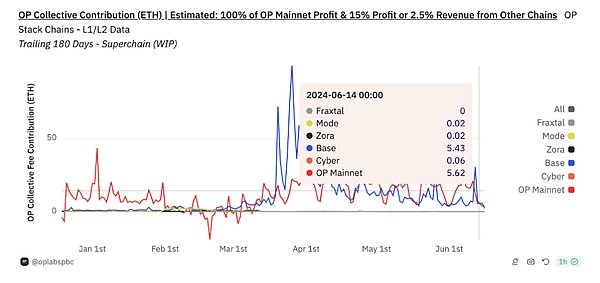
Source: OP Lab
1.3 Rollups Cost
1.3.1 Ethereum L1 data cost
The specific cost structure of each chain is different, but the major categories can be basically divided into communication costs, DA costs, and ZK Rollups-specific verification costs.
Communication cost: mainly includes state updates between L1 and L2, cross-chain interaction, etc.
DA cost: including publishing compressed transaction data, status root, ZK proof to the DA layer.
Before EIP4844, L1 costs mainly come from DA costs (more than 95% for Arbitrum and Base, more than 75% for zkSync, and more than 80% for Starknet)
After EIP4844, DA costs have dropped significantly, and due to different L2 mechanisms, the degree of reduction in DA costs is different, with a cost of about 50%-99%.
1.3.2 Verification Cost
It is mainly used by ZK Rollup, which is used to verify the reliability of Rollups transactions through ZK means.
1.3.3 Other costs
It mainly includes off-chain engineering and operation and maintenance costs.Due to the current Rollups operational approach, the operating cost of a node is close to the cost of a cloud server, which is relatively small (close to the cost of an enterprise AWS server)
1.4 Comparison of L2’s profits with other L1’s data
At this point, we have a rough understanding of the overall income-expenditure structure of Rollup L2, and can compare it with Alt L1. Here, Rollups chose Arbitrum, Base, zkSync, and Stakrnet weekly average data as data sources.

Source: Dune Analytic, Growthepie
It can be seen that Rollups’ overall profit margin is close to Solana, and has obvious advantages compared to BSC, reflecting the excellent performance of Rollups’ business model in profitability and cost management.

2.Rollup horizontal comparison
2.1 Overview
The fundamental performance of Rollups varies significantly at different stages of development.If there is an expectation of issuing coins in transactions, Rollups will usher in a significant increase in transaction volume, and the subsequent fee income and expenses will also increase significantly.

Source: IOSG Ventures
Most Rollups are still in their early stages, and absolute profitability is not that important to them. They are more about ensuring balance of revenue and expenditure and long-term development.This is also the philosophy that Starknet has always declared that no additional fees are charged to users and profit from this.
However, since mid-March, Starknet has been operating in a negative revenue state that has been operating to this day. Its on-chain activity is indeed poor, but what is the fundamental reason for negative revenue? Will it continue for a long time?
Let’s continue to go deeper with this question.In fact, the revenue structure of Rollups is relatively convergent, and because the marginal cost structure brought about by the Rollup mechanism of each chain is different, the different computer systems such as data compression methods also bring about cost differences.

Source: IOSG Ventures
We hope to compare costs in Rollups to help us compare horizontally what different Rollups have.
2.2 Cost structure of different types of L2
ZK Rollup
ZK Rollups mainly differs in verification costs. Verification costs can often be regarded as their fixed costs and are difficult to charge through sharing fees, which is also the root cause of Rollups’ inability to make ends meet.

Source: David Barreto @Starknet, Quarkslab, Eli Barabieri, IOSG Ventures
This article mainly discusses two relatively mature ZK Rollups with trading volume.
Starknet
Starknet uses SHARP, a shared verification service, to sort, confirm and block, and form a batch to build transaction proof through SHARP, send it to L1 contract verification, and then send the proof to the Core contract after passing.
The fixed costs of verification and DA in Starknet come from blocks and batches, respectively.
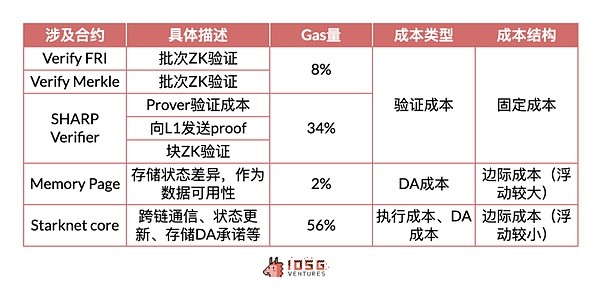
Source: Starknet community – Starknet Costs and Fees
The variable costs in Starknet increase with the number of transactions, mainly DA costs, which theoretically does not incur additional expenses.Actually, even the opposite – Starknet’s transaction fees are charged per write, but its DA cost depends only on the number of memory cells updated, not the number of updates per unit.Therefore, Starknet previously charged an overly high DA fee.
There is a time difference between the collection of transaction fees and the payment of operating costs, which may lead to partial losses or profits.
So we see that as long as there is a transaction still happening, Starknet needs to continuously produce blocks and pay the fixed costs of blocks and batches.At the same time, the more transactions, the more variable costs you need to pay.Fixed costs do not significantly increase marginal costs

Source: Eli Barabieri – Starknet User Operation Compression
Since Starknet has a limit on computing resources (Cairo Steps) for each block, its gas fee calculation method is to cover fixed costs and variable costs according to the size of the computing resources and data volume.Since the cost of block/batch is difficult to allocate to each transaction, but since each block is closed after reaching a certain computing resource (fixed cost is triggered), it can be calculated and collected by the dimension of the computing resource.cost.
However, due to the limitation of block production time, if the transaction volume is insufficient (the amount of calculation in a single block is insufficient), the computing resources cannot well measure the price that needs to be amortized, so the fixed cost cannot be completely covered.At the same time, the “restriction of computing resources” will be affected by the upgrade of Starknet network parameters. This is reflected in the significant losses in short-term operations after EIP4844. The losses will not be alleviated until the calculation resource parameters in the collected fees are adjusted.
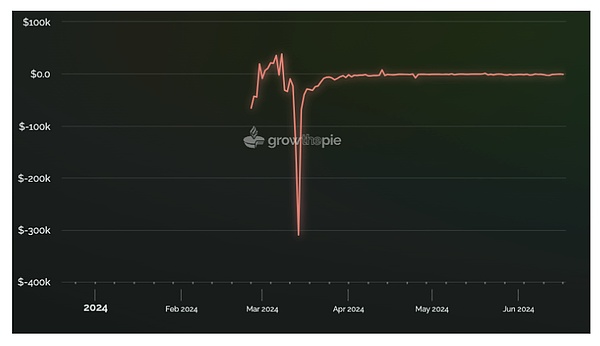
Source: Growthepie
Starknet’s charging model cannot effectively fill the fixed costs in each transaction, so when the Starknet main network is updated and the transaction volume is extremely low, negative revenue will occur.
zkSync (zkSync Era)
After Boojum upgrade, zkSync era shifted from block verification to batch verification and storage state differences, effectively reducing verification and DA costs.The process is basically similar to Starknet. Sequencer submits batches to Executor contracts (status difference and DA commitment), proves that node submits verification (ZK proof and DA commitment), and executes batches after verification (executes every 45 batches); the difference is thatStarknet has verification costs for blocks and batches, while zkSync has verification costs for batches only.
Cost comparison between zkSync and Starknet
Starknet batch size is much larger than zkSync Era, which has a transaction limit of 750 or 1,000 per batch, while Starknet has no transaction limit.

Source: IOSG Ventures
In this way, Starknet has stronger scale capabilities. Since each block has computing resource limitations, the ability to process more transactions and batches in a single block makes it more performing in scenarios where high-frequency transactions and requires processing a large number of simple operations.OK, but when the transaction volume is small, there will be problems with excessive fixed costs.zkSync’s compression efficiency and flexible block resources make it more advantageous when it needs to flexibly deal with L1 gas price fluctuations and lack of activity on its own chain, but there will be limitations in terms of block production speed.
For users, Starknet’s charging model will be more user-friendly, with less correlation with L1 and stronger scale effect.zksync is more efficient but will fluctuate more with L1.
For the protocol, Starknet’s high fixed costs will bring more losses in the stage of low activity, and zkSync will be more suitable for this scenario.In the stage of high activity, Starknet is more suitable for conducting large quantities of high-frequency transactions and controlling costs. zkSync’s current mechanism may perform slightly worse in high transaction volume.
2.3 Optimistic rollup
The cost structure of Optimistic Rollup is relatively simple. Without verification costs, users only need to pay the calculation cost of L2 and the DA cost of publishing to L1 data. The publishing of the status root is more fixed because it is related to block output.Uploading of compressed transactions is a variable cost that is easy to estimate and easily allocate.
Compared with Zk Rollup, its fixed cost is lower and it is more suitable for scenarios with appropriate transaction volume. However, since each transaction needs to include signatures, the cost of DA will be higher, which is caused by marginal costs in the large-scale adoption stage.The advantage is relatively smaller.
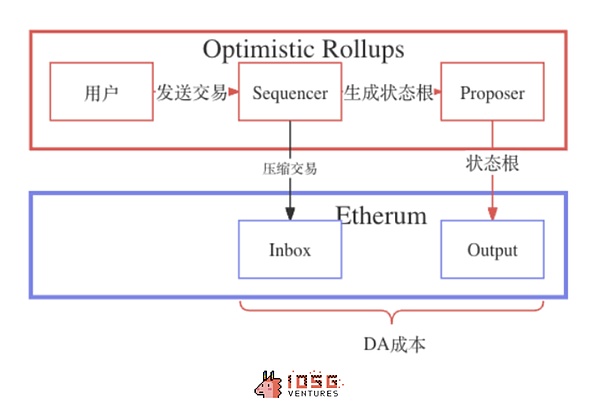
Source: IOSG Ventures
Based on the current adoption scale, the fixed cost of ZK Rollup may lead to a higher lower limit on unsubsidized transactions. Compared with OP Rollups, ZK brings costs to users, but the advantage of ZK is clearly lies in its scale:
High transaction volume and proof aggregation will verify cost sharing, and ultimately the marginal cost savings of L1 will exceed Optimism Rollups; running Validiums/Volitions and DAs that only require status differences, faster withdrawal speeds, etc. will be more suitable for economic needs of scale andRaaS ecology.
2.3 Data comparison
income
Rollups charges gas fees to users, and we can see that Base revenue is higher, Starknet revenue is lower, Arbitrum and zkSync are flat, and the difference in transaction volume leads to horizontal and vertical gaps, so we calculate the revenue per transaction.You will find that before the EIP4844 upgrade, Arbitrum had higher revenue per transaction, and after the upgrade, Base had higher revenue per transaction.
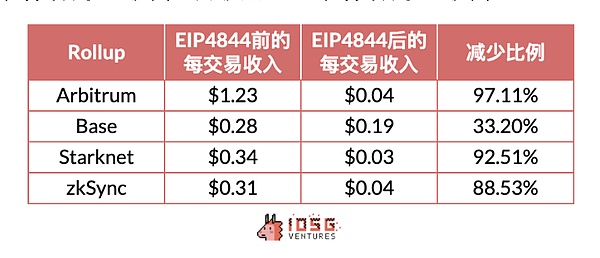
Source: IOSG Ventures
cost
Judging from the cost of each transaction, before EIP4844, Base was too high for DA costs, which led to excessive transaction costs, and was actually in a situation where marginal costs were high, and the cost advantage caused by scale effects was not reflected.After EIP4844, with the significant reduction in DA costs, Base’s transaction costs per order plummeted, and it is currently the lowest transaction costs among all Rollups.Compared with ZK, OP Rollups can be seen as a bigger beneficiary of the upgrade. The actual cost of StarkNet’s L1 DA can be reduced by about 4 to 10 times, slightly less than OP Rollups.This is also consistent with theoretical inference: in the EIP-4844 upgrade, the ZK Rollups’ benefits are not as large as those of OP Rollups.ZK Rollup’s cost performance after upgrading also reflects the impact of fixed costs on it.

Source: IOSG Ventures
profit
According to the data, Base’s gross profit is the highest due to its scale effect, far exceeding that of Arbitrum, which is also Optimistic.Starknet, which is also ZK Rollup, cannot cover fixed costs due to the low transaction volume, resulting in negative transaction gross profit, while zkSync is positive, but is also limited by fixed costs, which is lower than OP Rollup.The upgrade of EIP4844 does not directly help the profit margin – the main benefit will be users, and their expenses and costs will be greatly reduced.

Source: IOSG Ventures

3. Summary
3.1 Cost side
It seems that most Rollups are still in the first half of their Margin curve. As transaction volume increases, marginal costs gradually decrease, and the average fixed costs will also be significantly reduced.However, after the rise of Ethereum L1 or L2 ecological transaction volume in the future, the increase in average transaction costs due to the network capacity will lead to a gradual upward trend of marginal costs (as can be seen from Base3-May performance), which cannot be ignored in the long-term development of Rollup.question.When focusing on cost changes caused by short-term adoption, we also need to focus on the efforts made by Rollups on the long-term cost curve.
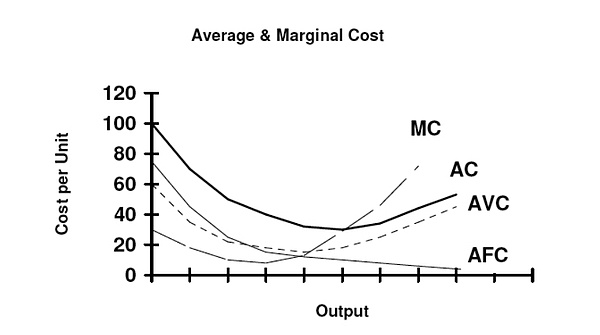
Source: Wikipedia – Cost curve
In the short term, for Rollups, more effective reduction of marginal costs is the best way to establish barriers, among which adjusting revenue and cost models to market conditions is a better solution.
3.2 Income side
In order to maintain long-term competitiveness, the agreement should not charge additional fees to users as much as possible, and even pay for fees to keep user expenditures as low and stable as possible, as we see the current situation of Starknet.Priority fees will certainly bring more income, but the premise is that the chain must have sufficient activity.
After EIP4844, some Rollups’ revenues have dropped significantly (such as Arbitrum), due to the fact that some of the profit gap – the hidden revenues of the DA data expenses part have been almost erased.Rollups’ revenue model will become relatively single, mainly tapping from L2 fees. As transaction volume increases, priority fees and congestion fees generated will be important revenue components.At the same time, in terms of active income, withdrawing MEV through Sequencer will also be one of the important revenue sources for Rollups in the future.
Overall, Rollups’ business model does have the advantages of economies of scale, especially ZK Rollups.The current market situation is not suitable for Rollups to play its advantages, and they all need to wait until a Base moment similar to that of March-May this year.The diversity of business models and the adaptability of different Rollups in different market states also allow us to see the far-reaching considerations of the Ethereum L2 Rollups ecosystem.
References
https://community.starknet.io/t/starknet-costs-and-fees/113853
https://medium.com/nethermind-eth/starknet-and-zksync-a-comparative-analysis-d4648786256b
https://blog.quarkslab.com/zksync-transaction-workflow.html
https://www.alexbeckett.xyz/the-economics-for-rollup-fees/
https://davidecrapis.notion.site/Rollup-are-Real-Rollup-Economics-2-0-2516079f62a745b598133a101ba5a3de
https://arxiv.org/pdf/2405.00138
https://blog.kroma.network/l2-scaling-landscape-fees-and-max-tps-fe6087d3f690
https://forum.arbitrum.foundation/t/rfc-arbitrum-gas-fees-sequencer-revenue/24730
https://mirror.xyz/filarm.eth/aZwXFN-tfuZKrMjzT9rXchlY15HGuYJGGj_5FPtPZ88
https://x.com/ryanberckmans/status/1768290443425366273
https://mirror.xyz/lxdao.eth/CnZFjWYHbR1Vu9Z4UPa7JKDceLtVtNf1EfsQ98Zq7JI

